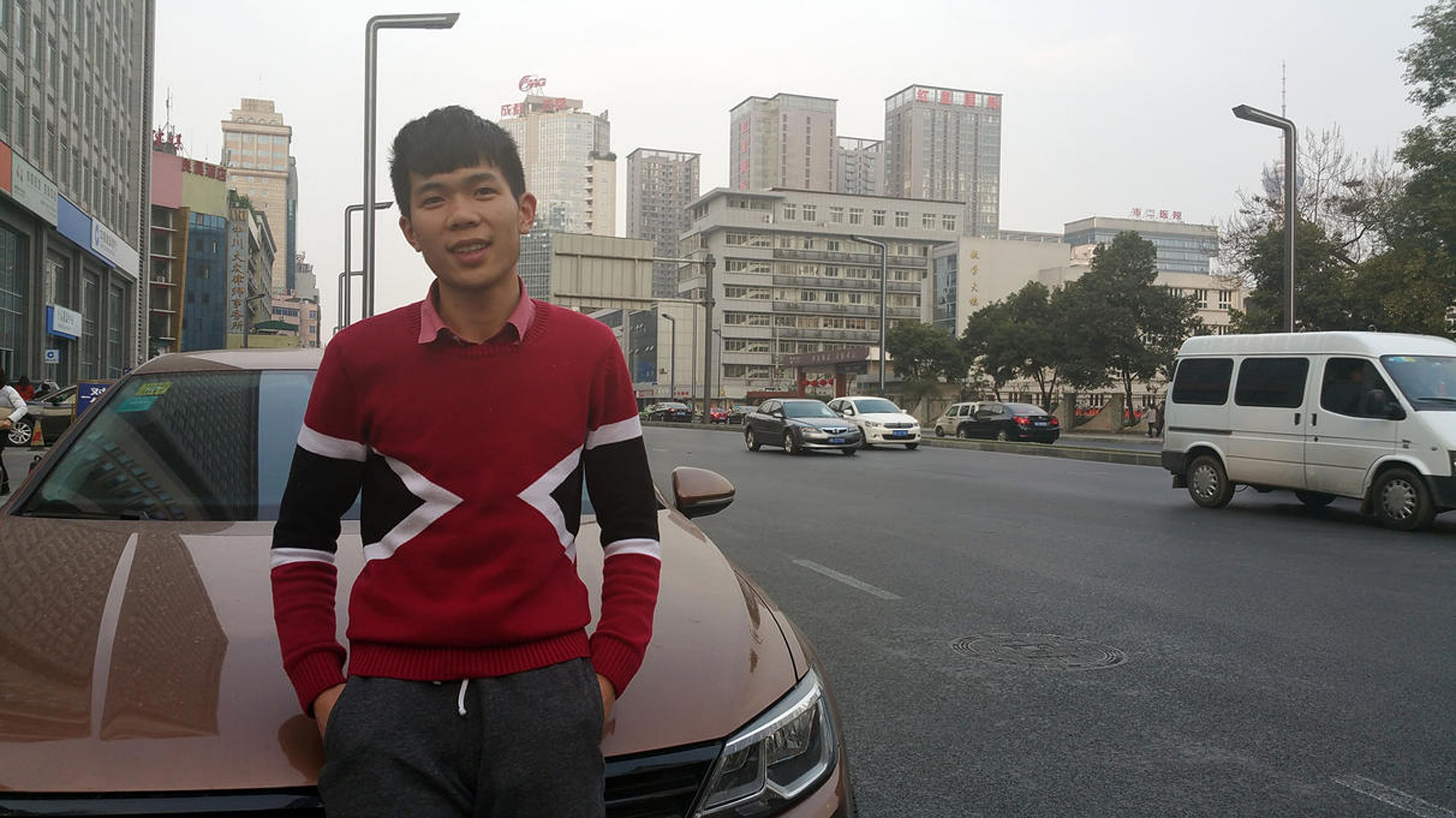JINTANG COUNTY (Sichuan) • The food wasn't as spicy, the working hours were long, and he was homesick during his first stint as a migrant worker.
So, after just over a year of working at a construction site in northern Hebei province's Tangshan city, Mr Shen Bing, now 23, packed his bags and returned home to south-western Sichuan province's Leshan city last year.
Now working as an Uber driver in provincial capital Chengdu while he tries to set up a car-grooming business, Mr Shen, who got married last year, said he is unlikely to seek work in other provinces again.
"I missed the Sichuan food and the way of living here. I don't think I will leave again even if the pay is good, especially since my family is here," he told The Straits Times.
Mr Shen's story mirrors a growing trend in China, where more migrant workers are returning and staying closer to home, one of the key factors leading to China's migrant population last year shrinking by 5.68 million to 247 million - its first dip in some 30 years.
It has led to shrinking migrant numbers in coastal cities. Shanghai, for instance, saw a 1.5 per cent dip in migrants last year, its first decline since 2000.

Several factors are at play for the slowing flow of migrant workers.
China's falling birth rates have led to shrinking family sizes and workforce and in turn, fewer migrant workers. An ageing society means migrant workers are getting older and deemed less employable, while Chinese youth are reluctant to take up factory jobs far from home.

A key reason, however, is the slowing economic growth and the industrial upgrading efforts in the coastal provinces that have rendered many migrant workers jobless. For these workers, going home seems a logical choice as costs of living in the inland regions are lower and growth in some provinces, such as Sichuan, remains high.
Government policies to boost urbanisation and rural entrepreneurship in the inland provinces, along with President Xi Jinping's initiative to revive the ancient overland Silk Road that benefits the western provinces, have also made home more appealing.

The trend of returning migrant workers, dubbed fan xiang chao in Mandarin, is most evident in labour-abundant Sichuan, which has 24 million of its 81 million residents working elsewhere.
The province saw 1.36 million returning home in the first three months of 2015, a 7.8 per cent spike from the previous year. It also registered a 3.7 per cent drop in the number of Sichuan natives venturing out in the same period last year.
This trend is seen in Chengdu's Jintang county, about 70km from the city centre, especially in Zhugao town, which was dubbed "China's No. 1 town of migrant workers".
In 1988, a busload of 50 workers left Zhugao for Houjie town in southern Guangdong province's Dongguan city as part of an inter-town pact on labour supply.
Over the years, as many as 600,000 Zhugao residents went to work in the shoe and garment factories of Houjie. At the peak of that migration, in the late 1990s, there were some 300,000 Zhugao natives in Houjie.
TIDE REVERSAL
The tide reversed in recent years as the Zhugao authorities tried to increase its labour supply to rev up the local economy by enticing its people back through various schemes. For instance, it provides a 50,000 yuan (S$10,500) subsidy for those setting up new businesses and a 100,000 yuan subsidy for those setting up farmstays.
The response has been positive as returning migrant workers have set up some 40 shoe and garment factories in Zhugao, compared with just six in 2007. Also, the number of Jintang people working outside Sichuan reportedly fell from 170,000 in 2007 to 50,000 now, helping to boost the county's population from 840,800 in 2001 to 898,000 at end-2013.
Now, there is only one Zhugao-Houjie bus daily, said a supervisor at the bus station, who declined to be named, adding that there were up to five buses daily at its peak.
One of the Jintang locals who tapped the entrepreneurial subsidy is Madam Wang Hongqiong, 44, who was one of the town's 50 pioneer migrant workers on that first bus in 1988 to Houjie.
In 1998, she returned to work in Chengdu and in 2007, she started a garment business in Zhugao that now employs some 200 employees - mostly former migrant workers.
Madam Wang said most of her employees are women in their 40s who had worked in Dongguan and returned home in recent years after they had their second child. "Almost all had gone out to work though they had just become parents because there was simply no work here. It meant their children grew up as 'left-behind kids'.
"But now, they are coming home after having their second child because they don't want to relive the same regret of leaving their child behind, and also because it is easier to find jobs here," she told The Straits Times.
One of her employees, Madam Xia Yuru, 45, was glad that she returned home in 2005 to take care of her second child, a girl born in 2001. She said she is earning about the same salary of 2,500 yuan monthly, and can go home to have lunch prepared by her daughter.
"I spend less here compared with Dongguan as I walk to work. Also, nothing beats being able to eat daily with my daughter," said Madam Xia, whose elder child, a 25-year-old son, is working at a restaurant in Sichuan's Mianyang city so as not to be too far from his family.
Family is also a key factor in Mr Diao Jihong and his wife returning home to Jintang's Guanxing town in 2012 after a decade of working at a shoe factory in Dongguan where they earned a combined 5,000 yuan monthly and led a busy life.
Though they could have looked for other jobs in Dongguan or taken up other well-paying jobs outside Sichuan, the couple - both aged around 50 - are staying put to be with their family.
It is a move that pleases their son Diao Jun, 26, who laments how he could not celebrate Chinese New Year with his parents in the 10 years they were away.
His parents' experience made Mr Diao, who works at a state-owned museum park and earns close to 10,000 yuan monthly, decide not to work outside Sichuan.
"When my parents first returned home, I could hardly chat with them as we hadn't spent much time together. As a left-behind kid, I wouldn't want to follow in their footsteps," said Mr Diao, whose thinking could help explain why fewer Sichuanese are venturing out now.
BOON AND BANE
Analysts say the phenomenon of more workers staying home is both a boon and a bane to inland and coastal provinces.
On the one hand, it helps lower the number of left-behind kids and neglected elderly in the hometowns and alleviates the potential social ills arising from them. For instance, there were three million left-behind kids in 2007 and the number fell to 2.23 million in 2013 in Sichuan.
Dr Zhang Mingming, who studies migrant worker issues at the Sichuan Academy of Social Sciences, said returning migrant workers also bring home with them work experience and skills that have helped raise the overall standards of the Sichuan workforce.
Also, from January to November last year, about 42,000 migrant workers - an increase of about 10 per cent from the previous year - had set up some 16,000 enterprises in Sichuan, creating 213,000 jobs and production value of 934 million yuan.
Going forward, Dr Zhang said, it is important for inland provinces to extend the social safety net to returning migrants who have lived in coastal cities that have extended public services to them as part of the country's urbanisation push.
"To do so, the local government has to start viewing migrant workers as part of the future urban population, instead of treating them as a transient group," he told The Straits Times.
In China, each person has a household registration, known as hukou, that is tied to the birthplace. Cities usually limit their policies to locals or place restrictions on those born elsewhere. That means migrants returning to their home provinces but working in cities away from their hometown might still face restrictions.
Also, analysts say the local authorities must be able to manage the return of migrants by sustaining economic growth or face deepening unemployment pressure. For instance, the Diaos have been unable to find new jobs since their return home.
"It has not been easy. Being home means higher expenses as there are weddings and birthday celebrations to attend and to buy gifts for," said Mr Diao. "We're also still young enough to work, but it is too difficult to find jobs in the county."
Other locals say that while the returning migrant workers have revitalised the county, the increased numbers have also led to a rise in prices of essentials like property and food.
Mr Liu Pingyuan, 50, who returned to Zhugao in 2011 to take care of his parents after working as a chef in Guangdong and south-western Yunnan province since 1999, said it has been tough running his restaurant in the town due to rising costs.
As for coastal provinces, the depleting supply of migrant workers makes it more crucial for companies there to increase productivity through automation and research, said Professor Lin Jiang, a migrant worker expert at the Sun Yat-sen University in Guangzhou city.
He believes the migrant worker numbers in coastal cities will continue to fall till next year, which might help these cities attract different types of investors.
"Some investors aren't keen to invest in high-end consumption sectors such as healthcare and culture in cities with large migrant populations. So the decreasing numbers may help these cities in transforming their economies," he said.
- Additional reporting by Lina Miao in Beijing

